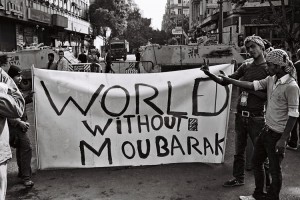 Waking up to what looked like a new dawn, and not only in Egypt, a woman on Tahrir Square, who had participated in the last phase of the revolution, said on the morning of Saturday, February 12, “I can’t imagine all this really happened: Who did it?”
Waking up to what looked like a new dawn, and not only in Egypt, a woman on Tahrir Square, who had participated in the last phase of the revolution, said on the morning of Saturday, February 12, “I can’t imagine all this really happened: Who did it?”
This revolution has been dubbed the revolution of the “street,” the revolution of “shabab al-facebook” (“the youth of Facebook”), but also the revolution of al-Jazeera. An astounding variety of people took part in it: everyone from Sufi practitioners to organized soccer fans. The subject of revolution is always elusive. In this case, due to the extraordinary combination of self-organization on the ground and the supportive role of a vast array of so-called new media, the elusiveness is even more striking. One should not forget the “preparatory” contribution of literature, movies, and TV serials. A few years ago, The Yacoubian Building, originally a novel by dentist Ala al-Aswani, which made a splash in all three genres (the movie was the most expensive ever produced in Egypt), depicted, in dramatic tones, the corruption of several layers of Egyptian society, particularly that of a crucial chunk of the Egyptian bourgeoisie—the nouveaux riches, infamously dubbed ‘fat cats’ after Sadat’s launch of a policy of infitah (economic opening) in the mid-1970s, and who also came to dominate the ruling party during the Mubarak regime. In real political life, this stratum was ultimately epitomized by none less than the son of Hosni Mubarak, Gamal, long a candidate for his father’s succession, which the Egyptian public bluntly but correctly dubbed “tawrith” (‘inheriting’), and, not by chance, the first target of the revolution (and the easiest to fell).
The arduous search for the most likely combination of the subjects of the revolution might reveal, by contrast, that revolution is an unlikely sociological category and rather lies at the core of the mythology of political modernity. It provides modern popular politics with the image of a climax of “shock and awe,” a heroic exit from the political routine of intimidation and subjection, unleashing an abnormal energy neatly substituting (or substantiating) traditional messianic expectations.
The sublime self-constitution of “the people” (al-sha‘b) in Egypt was well reflected in al-Jazeera’s coverage. The first and strongest slogan on the street since January 25 was, not surprisingly, “al-sha‘b yurid isqat al-nidham” (“the people wants/wills the fall of the regime/system”), yet al-Jazeera promptly edited it into the simpler “al-sha‘b yurid . . . .” This became the running headline for al-Jazeera’s characteristically well-assembled and dramatized footage, with its soundtrack reminiscent of the popular hits of the 1950s and 60s, exuding post-colonial pride and dreams of progress and emancipation supported by a common Egyptianness, located at the peak of, but also beyond, pan-Arab belonging. The suspension signified by the final dots in the shortened and edited slogan by al-Jazeera stressed the intrinsic openness of popular will, which, so goes the myth, cannot be restricted by contingent, specific demands, which were nonetheless uttered and clearly formulated by the revolutionaries on the streets (and still are, perhaps now even more).
The rather visionary and almost naively romanticizing view of revolution propagated by Michel Foucault, reporting on the Iranian uprising a third of a century ago from the columns of the Italian daily Corriere della Sera, has become commonplace among observers: “People rebel, this is a fact: and it is in this way that subjectivity comes into history and gives it its spirit.” He even wrote of “political spirituality,” which earned him the accusation of confusing spirituality with fanaticism. But what was most clear in the way he talked to the people on the streets of Tehran was that he could not avoid feeling surprised and even uneasy when hearing from them that the uprising was perfectly understandable within the Western categories of political modernity. At that time, a debate had been ignited within the European left as to whether that event should be termed a real revolution, sharing this label with the French and Russian ones. Thirty-three years later, this is no longer in question, and rather the opposite is happening, at least among scholars of Egypt and the Middle East, and among the suddenly booming cohorts of public intellectuals: we see, rather, something like an anti-orientalist compulsion to immediately frame the Egyptian revolution within rigorously universal categories. I am not critiquing this compulsion, which has good reasons to be, but the fact that it can easily slip into renewed and ever more blatant forms of Eurocentrism.
The most widely exposed public intellectual on this front is probably Slavoj Žižek, who in speaking and writing about the event has, more than once, used an example drawn from Tom & Jerry cartoons: “the cat reaches a precipice but goes on walking, ignoring the fact that there is no ground under its feet; it starts to fall only when it looks down and notices the abyss.” What Žižek does not specify is whether the cartoon cat is a Third World dictator and his rotten regime exhibiting an insane resilience towards surrendering to the inevitable triumph of universal freedom and the norms of justice and democracy (which would be a token of a resurfacing sense of European moral superiority towards the rest of the world, which is allegedly late—yet, better late than never—in capturing the movement of the Hegelian spirit of history), or something more than that, i.e., a token of a pretended universal, yet originally European entity (the fate of the European, Westphalian state, extended to the rest of the world in colonial times, and now being caught offside in the developments of history).
The critical wit of the Egyptian “street” could depict the situation in similarly plastic terms with a joke during the same hours in which people were mowed down by the hundreds on the Black Friday of January 28 (when security forces used live munitions and made a blood bath, while communications were shut down with the complicity of telecom companies): “Mr. President, isn’t it time to prepare a farewell speech to the people? Why, where is the people going?’’ Yet, as the protesters shouted from the beginning, it was not Mubarak or his son, his family, his clan, his pseudo-party that looted the Egyptian economy for thirty years, but al-nidham, the system, that was the target of their well-directed rage (as much as Mubarak was an ideal character in the unending chain of critical jokes leading up to the final outburst). The real correlate of the cartoon cat was therefore the “system,” a system that lacks awareness since history has exempted it from needing such consciousness. Al-nidham is here a lucid, sociologized name for the state, a name that in Western languages has little sociological depth, and is indeed more like a mystical tautology. (I am exempting myself here from venturing an analysis of the difference between the “state” and its Arab counterpart dawla, which would just evoke the sinister ghost of Bernard Lewis and his old orientalist attempts to make a point of comparing plain words.)
If the mythology of revolution indicates a pure state of popular will, the mysticism of the state—its modern political theology—reposes on a redundancy: a mysterious ritual of self-establishment that literally allows it to float in the air without the need to look down; it does not need awareness since it is itself, in Hegelian parlance, the peak of consciousness, spirit incarnate. Every state, by definition, walks on the edge of—and indeed across—a precipice: not just by demanding that millions of citizens comply with the law by imposing just a modicum of violence in routine times but also, as more people in the world are now becoming aware, by piling up hundreds of billions of “sovereign” debt for decades without anybody really worrying about it.
This might happen with or without corruption—surely, if the “fat cats,” all the way up to the president, took a large part of that pile of cash into their own accounts, the cat’s game of floating in the air becomes a caricature of itself. Yet, in itself it is neither a caricature nor a cartoon, but the very image of what the state is about, the outcome of a collective entrancement that makes a docile subject out of popular multitudes who know how to organize themselves. Indeed, matching this kleptomaniac, steady drainage of resources under the regime of Mubarak, these thirty years witnessed a spectacular rise of social self-organization and solidarity in a variety of sectors (health and education first) that has blurred the boundary, imposed by the modern state and its weak imaginary, between “formal” and “informal” associations and networks, between “religious” and “secular” NGOs.
Yet, within the collective trance staged by the state, the multitudes as “the people” are none other than the state. In the trance routine, they are its very collective body: at best, they can imagine inhabiting a parallel space called “civil society,” which, however, only exists and flourishes in a symbiotic relationship with the state and manages to pump citizens’ energies “voluntarily” in the “non-profit” sector, thus creating social cohesion at low or zero cost. This is why the utopian wave of civil society of the 1990s that initiated the fall of authoritarian regimes in Eastern and Central Europe was anomalous, perhaps a first sign of the doubling or splitting of the ghost of the state, reflecting the rather weak idea that in a crisis situation the state can be saved by its “healthy” part, which is closer to the citizens.
In the post-Cold War, pre-War on Terror, long decade of the 1990s, the civil society wave spilled over to the Middle East for a short while and furthered hopes for democratization in the face of the perpetuation of various types of autocratic regimes, variably associated with ongoing neoliberal globalization. What was now left of that wave, and what worked perfectly well in the Egyptian revolution, was the potential of plain civil disobedience to make the simple move of stepping out of the sinister shadow of the floating cat.
Luckily, perhaps, the present revolutionary moment is not a replication of that civil society wave. The splitting of state and civil society to save the former through the latter became evidently unlikely through the inevitable role the military played from (or before?) the beginning, as a behind-the-scenes mediator and concocter of what has been termed a slow-moving coup. The problem is that in such a coup d’état sui generis, it is the état itself, its authority, that is not just suspended but revealed for what it is: a state of oscillation between illusion and delusion—first of all, in its promise to provide “security.” One of the first statements of the military when they deployed to the streets after Black Friday was a request to the citizens to get organized “among themselves,” to prevent acts of looting and violence. The military were the first to admit that, in the revolutionary situation, they could not impersonate the floating state, the cartoon cat, but could just “help” the citizens to get ready for the sobering yet dangerous touching of the ground, of the bottom line of life and suffering, after everybody except the core of the “system” recognized that the floating was over.
Psychologically (and here Žižek and his psychoanalytic toolkit can become more useful), this breaking of the state of trance opens a glimpse of the Real, beyond the Big Other of the state. A glimpse of the terrible, beautiful, and impossible realm of the pure affirmation of people’s needs (starting with cooperating in the protection of their bodies and their means of subsistence—something different from “security” in modern political parlance), beyond subjectivity itself, triggered by grievances ultimately sublimated into a hard politics of presence, of something that can get trivialized into the universal terms of “popular will” for the sake of self-identification, comment, and press coverage, but is ultimately impossible to grasp: “Who did it?”
Not just collective effervescence or aural-charismatic leadership (as many fathers of sociology described the recipe for social transformation, evidently needing to obliquely borrow from the language of ecstatic and mystic religion), but almost its opposite, a reckoning with illusion and delusion as the Real-ization of the bottom line. No longer floating in the air, but touching, even if just for a blessed moment, the Real ground of suffering, solidarity, and joy.
The state of exception represented by a revolutionary situation suspends the illusionary exception of a state floating in the air and defying life and common sense in the name of a higher “security.” The Real of Revolution is terrible in the sacrifice of young life, beautiful in the explosion of joy, and, in the long term, impossible—but it is exactly for these reasons that it is much more real than the routine entrancement of the state and can provide an abiding bottom line to the enduring (and, in the long term, indispensable) work of self-organization on the ground. In a country like Egypt, this ground was well in place before the outbreak of the revolution and should become the most precious asset in all possible post-revolutionary scenarios. The social of the Real is the bottom line of self-organization and solidarity existing alongside old and new states.














Perhaps one way, then, to probe the woman’s uncanny question, “who did it?” is to rephrase it as “how did WE CHANGE?” That is, how did the Egyptian people transform through their evolving actions, solidarities, dis-entrancements, real-izations, sufferings, etc., and in so undergoing and provoking such momentous change come out in a new possible ordering of life—and as its concomitant new “we”?
The way Armando ends up talking about the State in terms of Zizek’s cartoonish cat that has stepped over the precipice but fails or refuses (or to use a Zizekian term, short circuits) to recognize there is nothing holding it up should be applied to all talk of the economy. The “if Wall Street falls then so does Main Street” line is the threat of insecurity made by the “floating economy”—Hegelized “sovereign debt.”